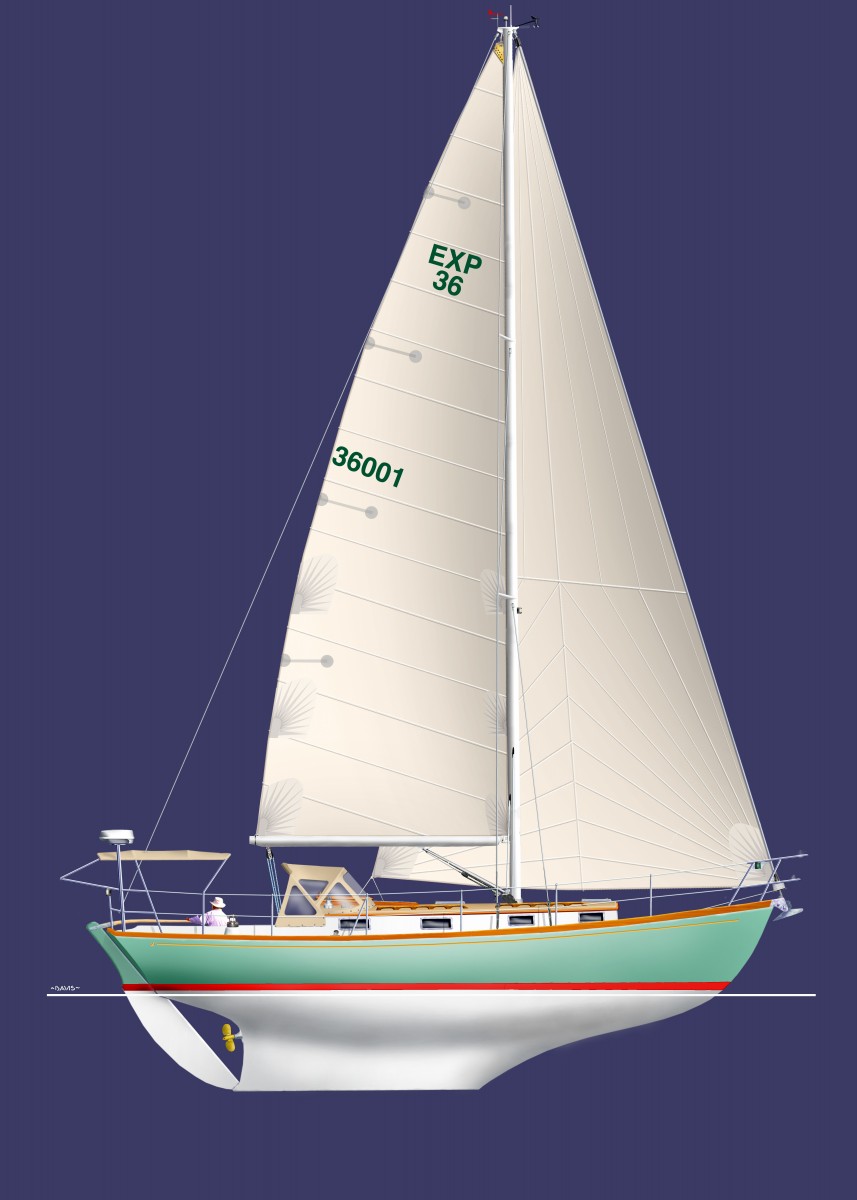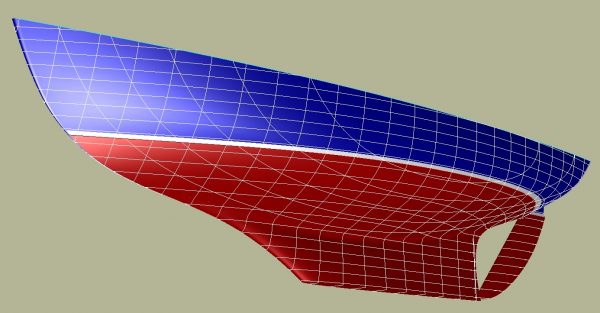EXPANNIE 36

DIMENSIONS
LOA: 36′ 3″
LWL: 30′ 0″
BEAM (excluding guards): 11′ 8″
DRAFT, on DWL: 5′ 2″
DISP, 1/2 load: 18,125 lbs
BALLAST: 7,000 lbs
SAIL AREA (100% fore triangle): 645 sq ft
SAIL AREA (IMS): 715 sq ft
SA/DISP: 16.86
SA/DISP (IMS): 18.70
DISP/L RATIO 250
Clients often ask which of my many designs would be my choice for my own retirement cruise. “Easy”, I will respond, “a scaled up and improved version of my beloved 30 foot ANNIE.”

THE PROGENITOR—MY LITTLE “ANNIE” – ONE OF THE FASTEST AND MAYBE THE MOST STABLE 29 1/2 FOOTER EVER. SHE WAS BEAUTIFUL, CLOSE WINDED, AND COMFORTABLE.
ANNIE had everything- she was beautiful to look at, had a wonderfully easy motion at sea owing to her heavy displacement, and never finished worse than first in any race she entered. I know that heavy boats need not necessarily be slow— it is the ratio between propulsive force (sail area) and resistance (displacement and wetted surface) that counts. So a heavy boat can be plenty fast, if the sailplan is large enough. And ANNIE is also extremely stable. Everyone knows that small boats whose decks stay reasonably level underfoot are far more pleasant to spend time aboard than ones that sail on their ear.
A few years ago I began designing my own retirement cruiser, one that never got built because the press of a growing business precluded any thoughts of retirement. It was an expanded ANNIE, which I naturally named “EXPANNIE“. I was ready for a larger boat than 30 feet and so the question then became, by how much to scale her up and what, if anything, to change.
In EXPANNIE I attempted to preserve all of the wonderful characteristics of the little progenitor, and to solve the problems that ANNIE has suffered; too little headroom for tall people, and the difficulty of getting aboard her if I wanted to go swimming. The headroom was easy- just scale her up to 36 feet or so and the problem solved itself. Reboarding from a man-overboard scenario or swimming required some original thinking, which is what a designer loves to do.

EXPANNIE’s keel is severely cut away forward, and additionally shortened by creating the huge aperture aft. Shortening the keel in this way increases its aspect ratio for better windward performance, significantly reduces the amount of wetted surface, and enables a partially balanced, almost spade-like rudder to be fitted.

The aperture enables a portion of the rudder to be forward of its pivot axis, making it for all intents and purposes a spade rudder with an additional support at its lower end. Because the center of pressure of the rudder is slightly aft of the pivot axis, very small helm forces are required no matter how much force the rudder is exerting.

EXPANNIE’s sailplan is tall and powerful, using a double spreader rig to bring the side shrouds inboard for a tight sheeting angle. Her mast is raked only slightly and she sports the same custom philosophy stemhead weldment that proved beneficial on her little sister. With a clean bottom and a bit of breeze that would reward her exceptional stability this heavy yacht could win races.

Here is her latest accommodations plan. I’ve lengthened the cabin aft, at the expense of the cockpit. The starboard quarter area is now a walk-in closet with huge amounts of storage space accessible from inside the boat – no deep sail locker on that side. At its front is a chart table where you sit on the new invention that no yachts should be without… a YETI or West System 12-volt freezer box. It is removable so you can take it home to pack it with frozen food before each voyage. The are outboard of the starboard settee xcan be either storage or a pilot berth depending upon the owner’s wishes. Although in order to maximize the sightlines and perception of space in the yacht, there is no permanent bulkhead opposite the head, a somewhat elaborate door enables the forward cabin to be visually closed off from the aft area. The forward veeberth consists of one normal length berth to port and one overly long and easier to access berth to starboard. Couples frequently consist of one tall and one shorter person, and if a single person uses that cabin he can choose the nicer berth and stow his duffel in the other.
EXPANNIE is a yacht designed according to the KISS principle, distinguishable from her contemporaries by what she does not have aboard as opposed to what she does. She will leave ashore electric winches, an electric anchor windlass, watermaker (she’ll have an easily valved rain catchment system), wind instruments (I was born with cheeks for this purpose), television (she’ll have books and an Ipad instead for entertainment), and anything that provides luxury at the cost of consuming electrons. She will have excellent central heating, pressurized hot and cold water for that shower I love, opening ports at eye height, numerous dorade ventilators, a few electric fans, very significant tankage for fuel and water, a sextant and tables for navigation if the satellites go down, superbly cut but simple non-laminated dacron sails, simple slab reefing, a roller furling genoa, a reliable diesel engine, and a small radar for cruising in Maine and (foggy) parts east. With so few electric whizbangs to go wrong and require fixing, she’ll spend most of her time actually out sailing with rare speed, power and grace.

The drawings for EXPANNIE are about one-third completed. Please contact me at; paineyot@aol.com if you would like to build this yacht… I would complete all of the remaining drawings at a very reasonable price. The yacht itself built to the highest standards will cost about US$ 1,150,000 in today’s inflationary times.
Chuck Paine
